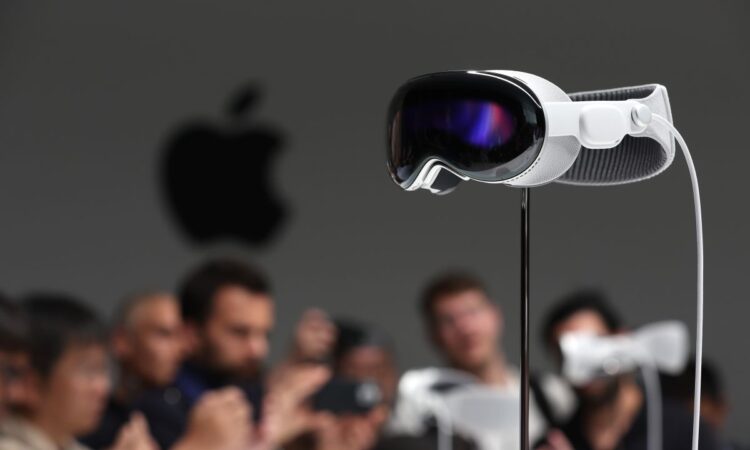Apple’s ‘Vision Pro’ Headset: ‘Let Us Strap the Screen to Your Face So You Never Stop Making Money For Us’ (Frankel)

To quote an article from The Information Tuesday, “judging a new Apple personal computing device is a fool’s errand.”
We can’t yet know if the just-introduced Apple Vision Pro headset will transform the currently moribund realms of augmented and virtual-reality computing in the same way that the the Macintosh and iPhone turned the personal computer and the smart phone into ubiquitous everyday tools that utterly changed the lives of global citizens.
Perhaps the Vision Pro, introduced Tuesday by Apple with lofty price of $3,499, will ultimately reside only on the unspectacular level of the iWatch, which leads the limited global smart watch category in sales … but you never see kids and adults almost get creamed crossing busy streets because they were too busy staring at their iWatch.
“Vision Pro is a new kind of computer that augments reality by seamlessly blending the real world with the digital world,” said Apple CEO Tim Cook while introducing the device at Apple’s Worldwide Developers Conference Monday. “It’s the first Apple device you look through and not at.”
Oh, and one more thing … Apple hasn’t introduced any new daily-life-changing computer hardware since founder Steve Jobs died in 2011 and left Cook in charge. But most of the core market dynamics that have traditionally foretold success for Apple appear to be awaiting the Vision Pro.
There’s a market here, but the incumbents have fallen short in terms of supplying for demand. Entertainment companies like Disney — which is an early Vision Pro partner — want to deliver new types of immersive experiences to the consumers they’re now engaging with directly.
And consumers are into it.
Consider that Meta has sold nearly 20 million $300 Quest VR headsets since it purchased Oculus, but the company formerly known as Facebook has experienced an engagement problem — consumers buy the Quest, play with it for a while, then leave it on the shelf.
The (overly?) self-confident high school baseball player living under Next TV‘s roof purchased an Oculus 2 last summer specifically to run a subscription-based VR application called WIN Reality. The app promised real-life simulation for batters facing 90+ MPH fastballs. You can punch in current big-league pitchers, including fire-baller Hunter Greene, and try to hit off them with an accessory attachment that connects your bat to the Quest headset.
But at least for our hitter, the technology fell shorter from that promise than a shallow fly ball to center. The boy ended up using his Quest for VR golf for a few months. Now it sits all day on top of the dog’s crate in his room.
For its part, Apple has historically known what needs to be done technology-wise to take an intriguing niche product, like, say, the Blackberry phone, and transform it into a must-have consumer gadget with a thriving app developer market.
The introductory price is always shocking. The first-generation iPhone was priced at $599 in 2007 (equivalent to around $876.40 in today’s money). The first Macintosh PC sold for $2,495 in 1984 (now equal to $7,484.80).
Even before the prices inevitably come down, we’ll start to see wealthy tastemakers influencing the market by using these Vision Pro in places like airports, and many of us will find a way to come up with 3,500 bucks. It’s the way flashy fashion-forward Apple hardware products work.
And the app market will broaden the category with all sorts of use cases we haven’t yet thought of. Imagine applying all those how-to YouTube videos on the internet to an augmented reality format? Imagine looking under the hood of a 2012 Nissan Pathfinder to replace a camshaft position sensor (left bank failed on Next over the weekend) while having an augmented-reality stream show you what you’re looking for and what steps to take.
Or how about those “watch party” features that became popular among streaming companies during the pandemic?
The possibilities for actual innovation seem far more prevalent here vs. watches and tablets, which weren’t transformative enough relative to the smart phone to truly replace its functionality.
The technology press is already rhapsodic, with The Verge headlining an early WWDC review with “I wore the Apple Vision Pro. It’s the best headset demo ever. TechCrunch, meanwhile, said its first impression is, “Yes, Apple Vision Pro works and yes, it’s good.”
But is the Vision Pro really a good thing … in the collective sense?
As many of us have powerlessly witnessed, Apple has developed monopolistic app markets around gadgets like its iPhone, creating a kind of Orwellian future of its own in which a single corporate interest accumulates a vast $2.8 trillion market capitalization.
This related to the progressive intrusion of technology into our personal lives.
Currently, the Vision Pro’s battery pack is only capable of two hours of sustained use before the device has to be recharged. At least for one Twitter critic, that seems to be the only thing stopping the device from turning us into mere monetization pods, directly exploitable 24/7.
Apple’s Vision Pro headset is a $3500 product designed to isolate you from your environment and strap a screen to your face so you’re constantly making money for tech companies.It’s not a vision for the future of computing we should accept. https://t.co/sz30d0zFGRJune 5, 2023






